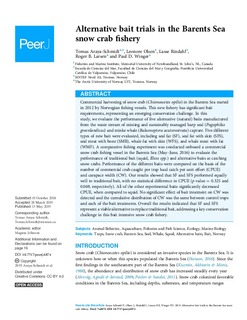| dc.contributor.author | Araya-Schmidt, Tomas | |
| dc.contributor.author | Olsen, Leonore | |
| dc.contributor.author | Rindahl, Lasse | |
| dc.contributor.author | Larsen, Roger B. | |
| dc.contributor.author | Winger, Paul D. | |
| dc.date.accessioned | 2019-12-19T13:16:52Z | |
| dc.date.available | 2019-12-19T13:16:52Z | |
| dc.date.created | 2019-11-14T12:58:28Z | |
| dc.date.issued | 2019 | |
| dc.identifier.citation | PeerJ. 2019, 7:e6874 (5), 1-21. | nb_NO |
| dc.identifier.issn | 2167-8359 | |
| dc.identifier.uri | http://hdl.handle.net/11250/2634166 | |
| dc.description.abstract | Commercial harvesting of snow crab (Chionoecetes opilio) in the Barents Sea started in 2012 by Norwegian fishing vessels. This new fishery has significant bait requirements, representing an emerging conservation challenge. In this study, we evaluate the performance of five alternative (natural) baits manufactured from the waste stream of existing and sustainably managed harp seal (Pagophilus groenlandicus) and minke whale (Balaenoptera acutorostrata) capture. Five different types of new bait were evaluated, including seal fat (SF), seal fat with skin (SFS), seal meat with bone (SMB), whale fat with skin (WFS), and whale meat with fat (WMF). A comparative fishing experiment was conducted onboard a commercial snow crab fishing vessel in the Barents Sea (May–June, 2016) to evaluate the performance of traditional bait (squid, Illexs spp.) and alternative baits at catching snow crabs. Performance of the different baits were compared on the basis of the number of commercial crab caught per trap haul catch per unit effort (CPUE) and carapace width (CW). Our results showed that SF and SFS performed equally well to traditional bait, with no statistical difference in CPUE (p-value = 0.325 and 0.069, respectively). All of the other experimental baits significantly decreased CPUE, when compared to squid. No significant effect of bait treatment on CW was detected and the cumulative distribution of CW was the same between control traps and each of the bait treatments. Overall the results indicated that SF and SFS represent a viable alternative to replace traditional bait, addressing a key conservation challenge in this bait intensive snow crab fishery | nb_NO |
| dc.language.iso | eng | nb_NO |
| dc.publisher | PeerJ | nb_NO |
| dc.rights | Navngivelse 4.0 Internasjonal | * |
| dc.rights.uri | http://creativecommons.org/licenses/by/4.0/deed.no | * |
| dc.subject | Traps | nb_NO |
| dc.subject | Snow crabs | nb_NO |
| dc.subject | Barents Sea | nb_NO |
| dc.subject | Alternative bait | nb_NO |
| dc.title | Alternative bait trials in the Barents Sea snow crab fishery | nb_NO |
| dc.type | Journal article | nb_NO |
| dc.type | Peer reviewed | nb_NO |
| dc.description.version | publishedVersion | nb_NO |
| dc.rights.holder | © 2019 Araya-Schmidt et al. This is an open access article distributed under the terms of the Creative Commons Attribution License, which permits unrestricted use, distribution, reproduction and adaptation in any medium and for any purpose provided that it is properly attributed. For attribution, the original author(s), title, publication source (PeerJ) and either DOI or URL of the article must be cited. | nb_NO |
| dc.source.pagenumber | 1-21 | nb_NO |
| dc.source.volume | 7:e6874 | nb_NO |
| dc.source.journal | PeerJ | nb_NO |
| dc.source.issue | 5 | nb_NO |
| dc.identifier.doi | 10.7717/peerj.6874 | |
| dc.identifier.cristin | 1747536 | |
| cristin.unitcode | 7401,1,0,0 | |
| cristin.unitcode | 7566,2,0,0 | |
| cristin.unitname | SINTEF Konsernstab | |
| cristin.unitname | Sjømatteknologi | |
| cristin.ispublished | true | |
| cristin.fulltext | original | |
| cristin.qualitycode | 1 | |

